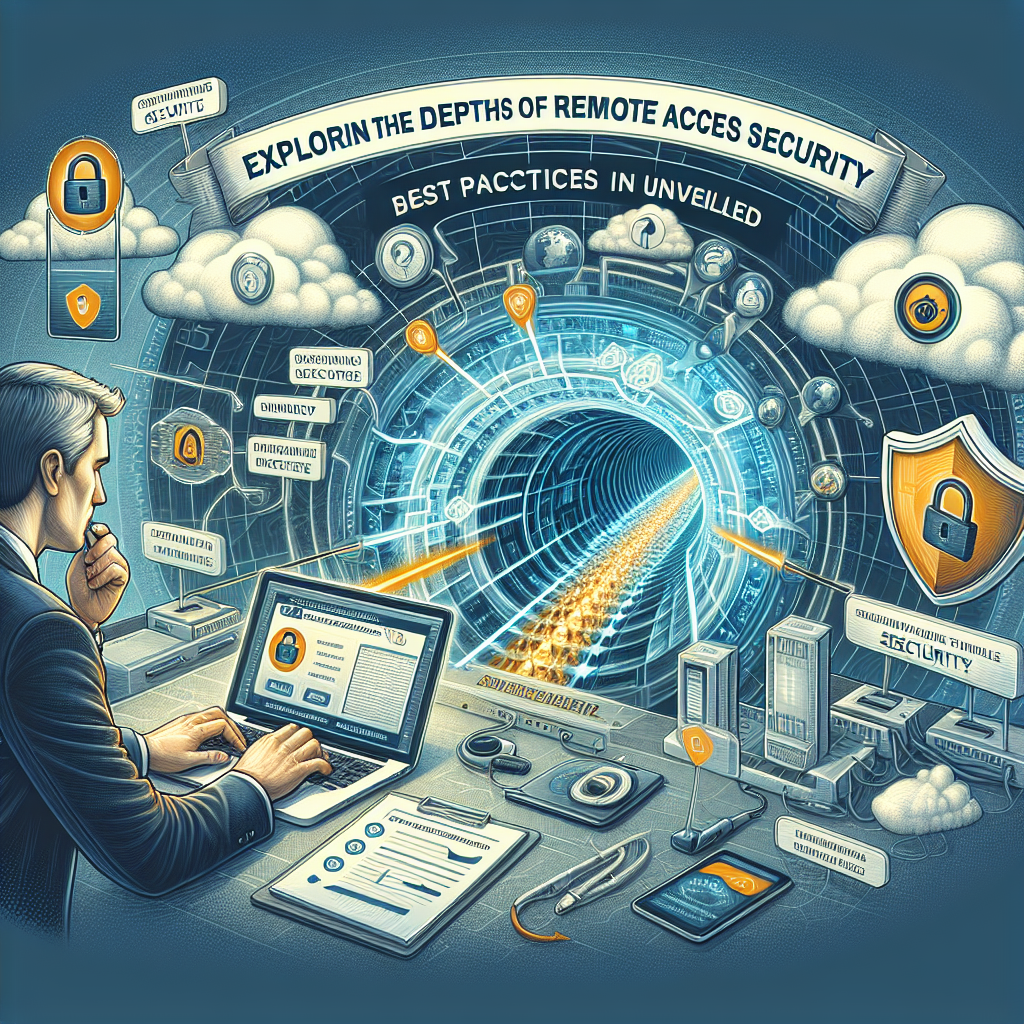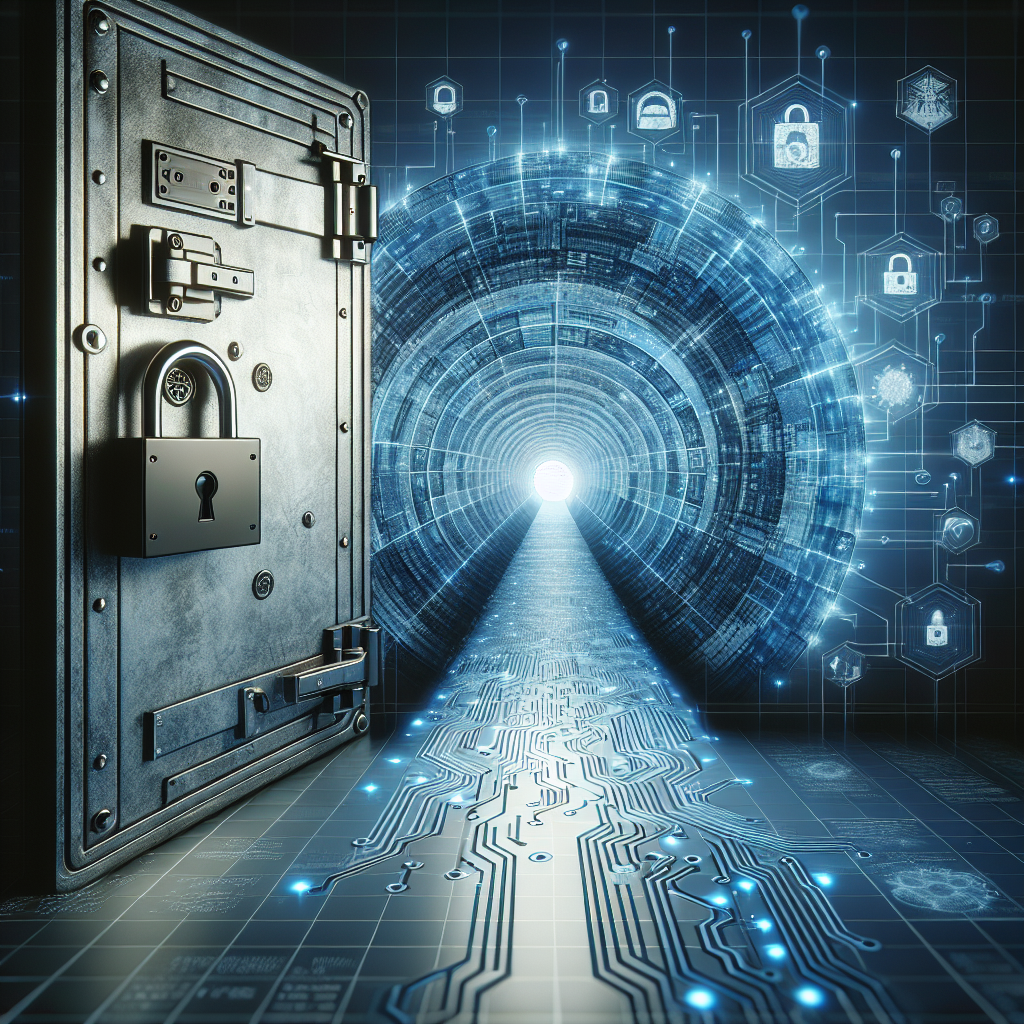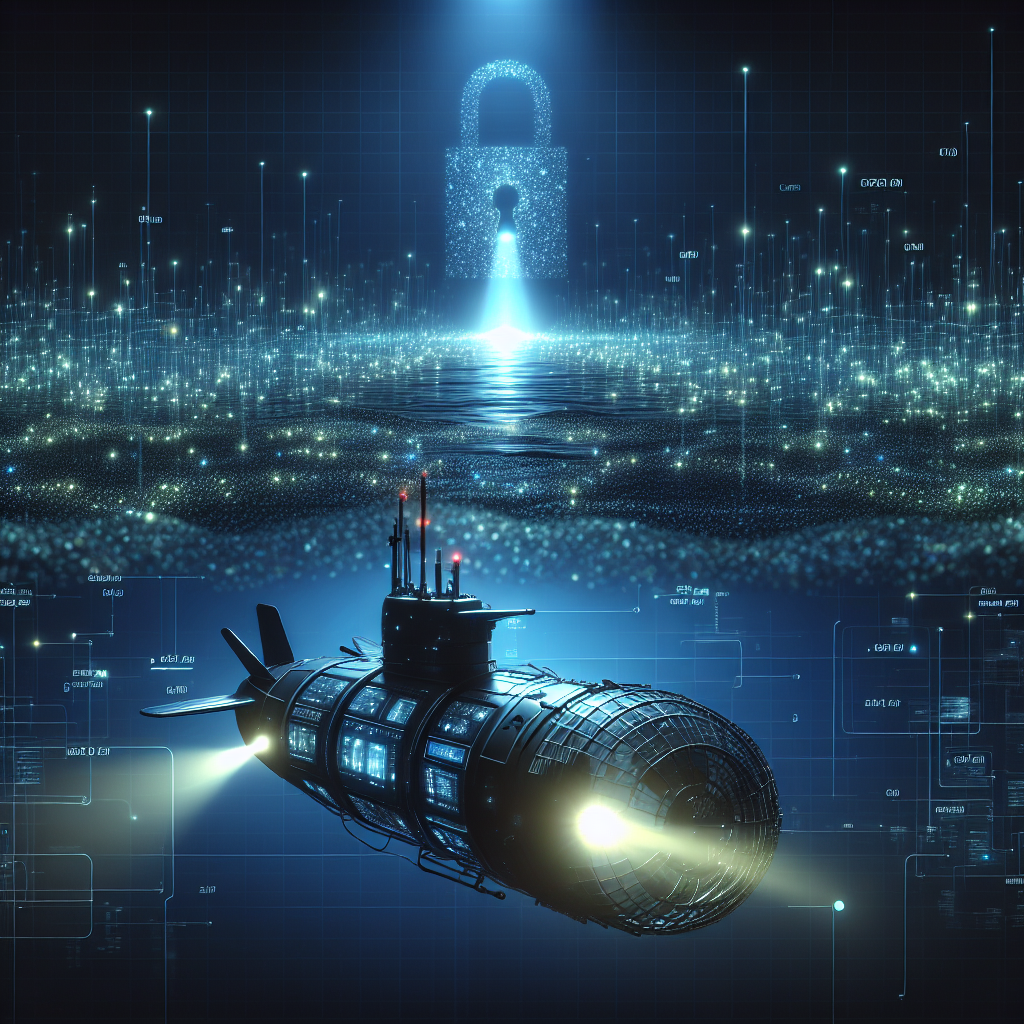In today’s increasingly digitized world, remote access has become an essential component of daily operations for businesses around the globe. The fast speeds of internet make this possible. However, with the convenience of remote access comes the inherent risk of potential security breaches. To mitigate these risks and ensure the safety of sensitive data, it is crucial for organizations to implement robust remote access security best practices. This comprehensive guide will delve into the intricacies of remote access security, uncovering the most effective strategies and protocols to safeguard your systems and data. Join us as we uncover the depths of remote access security to unveil the best practices for protecting your organization against cyber threats.
Understanding Remote Access Security
In the realm of cybersecurity, remote access refers to the ability for users to connect to a computer network from a distant location. This connection allows individuals to access resources, data, and systems as if they were physically present at the location of the network. Remote access is commonly used by employees working from home, travelers needing access to company files, or IT professionals managing systems from off-site locations.
The importance of remote access security cannot be overstated in today’s digital landscape. As organizations increasingly rely on remote access to conduct business operations, the security of these connections becomes paramount to safeguard sensitive information and protect against cyber threats. Failure to implement robust remote access security measures can expose networks to unauthorized access, data breaches, and potential financial and reputational damage.
Risks Associated with Remote Access
Understanding Remote Access Security
- Cybersecurity Threats
Remote access opens up networks to a myriad of cybersecurity threats, including malware, phishing attacks, and ransomware. Hackers can exploit vulnerabilities in remote access systems to infiltrate networks and launch devastating cyber attacks. Without robust security measures in place, organizations are at risk of compromising sensitive data and facing significant financial and reputational damage.
- Data Breaches
Remote access introduces the potential for data breaches, where unauthorized parties gain access to confidential information. Weak authentication protocols, unsecured connections, and lack of encryption can all contribute to data breaches when utilizing remote access. The repercussions of a data breach can be severe, leading to regulatory penalties, loss of customer trust, and legal consequences for organizations.
- Unauthorized Access
One of the primary risks associated with remote access is the possibility of unauthorized individuals gaining entry to corporate networks. Without proper access controls and monitoring mechanisms, malicious actors can exploit remote access channels to infiltrate systems and compromise sensitive resources. Unauthorized access not only jeopardizes data integrity but also undermines the overall security posture of an organization.
Implementing Secure Remote Access

When it comes to implementing secure remote access, organizations must prioritize robust measures to safeguard their systems and data from potential cyber threats. Below are some best practices to ensure secure remote access:
- Strong Authentication Methods: Utilizing multi-factor authentication (MFA) is essential to add an extra layer of security when users attempt to access the network remotely. This typically involves combining something the user knows (like a password) with something they have (such as a fingerprint or a unique code sent to their mobile device). By requiring multiple forms of verification, organizations can significantly reduce the risk of unauthorized access.
- Use of Virtual Private Networks (VPNs): VPNs create a secure tunnel for remote users to connect to the corporate network over the internet. By encrypting the data transmitted between the user’s device and the network, VPNs help prevent eavesdropping and data interception by malicious actors. Implementing VPNs ensures that sensitive information remains protected during remote access sessions.
- Role-Based Access Control: Implementing role-based access control (RBAC) allows organizations to assign permissions based on specific roles within the company. This means that individuals only have access to the resources necessary to perform their job functions, reducing the risk of unauthorized users gaining entry to critical systems. RBAC helps organizations enforce the principle of least privilege, limiting potential exposure in the event of a security breach.
Multi-Factor Authentication
Definition and Benefits
Multi-factor authentication (MFA) is a security process that requires multiple methods of verification to allow access to a system. This adds an extra layer of protection beyond just using a password. By combining two or more factors such as something the user knows (password), something the user has (smartphone), or something the user is (fingerprint), MFA significantly enhances security by making it more challenging for unauthorized users to gain access.
The benefits of implementing MFA include:
- Enhanced Security: MFA reduces the risk of unauthorized access, data breaches, and identity theft by adding an additional layer of authentication.
- Improved Compliance: Many regulatory standards and frameworks require the use of MFA to ensure data protection and privacy compliance.
- User Authentication: MFA helps verify the identity of users, ensuring that only authorized individuals can access sensitive information.
- Protection Against Password Attacks: MFA mitigates the risks associated with password-related attacks such as phishing, brute force, and credential stuffing.
Types of Multi-Factor Authentication
There are several types of MFA methods that organizations can implement based on their security requirements and user convenience. Some common types include:
- SMS or Email Verification: A one-time code is sent to the user’s registered phone number or email address for verification.
- Token-Based Authentication: Users are provided with a physical or virtual token that generates a time-sensitive code for authentication.
- Biometric Authentication: This includes fingerprint scans, facial recognition, or iris scans for user verification.
- Push Notifications: Users receive a notification on their mobile device to approve or deny access attempts.
- Hardware Tokens: Physical devices like USB keys or smart cards are used in combination with passwords for authentication.
Each type of MFA has its strengths and weaknesses, and the choice of method should be based on the organization’s security policies, user convenience, and the sensitivity of the data being accessed.
Virtual Private Networks (VPNs)
Virtual Private Networks (VPNs) play a crucial role in enhancing remote access security by creating a secure and encrypted connection between a user and a network. This technology helps to protect data transmission over unsecured networks, such as the internet, by establishing a private tunnel that prevents unauthorized access and interception of sensitive information.
How VPNs Enhance Security
- Encryption: One of the primary ways VPNs enhance security is through encryption. By encrypting data traffic, VPNs ensure that even if intercepted, the information remains unreadable to unauthorized parties.
- Anonymity: VPNs provide users with anonymity by masking their IP addresses. This makes it more challenging for cybercriminals to track or trace the online activities of remote users.
- Secure Remote Access: By requiring authentication before granting access, VPNs ensure that only authorized users can connect to the network remotely. This adds an extra layer of security against unauthorized access attempts.
Choosing the Right VPN Service
- Protocols: When selecting a VPN service, it is essential to consider the encryption protocols offered. Strong protocols such as OpenVPN or IKEv2 provide better security than weaker options like PPTP.
- Logging Policies: Reviewing the logging policies of VPN providers is crucial. Opt for services that have a strict no-logs policy to ensure that your online activities are not recorded or stored.
- Server Locations: The location of VPN servers can impact performance and security. Choose a service with servers strategically located to ensure fast and secure connections for remote access.
Role-Based Access Control
Role-Based Access Control (RBAC) is a method of restricting network access based on the roles of individual users within an organization. The purpose of RBAC is to ensure that users only have access to the information and resources necessary for their specific job functions, thereby reducing the risk of unauthorized access and data breaches.
Best Practices for Implementing RBAC:
- Define Clear Roles and Responsibilities: Start by identifying different roles within the organization and clearly defining the responsibilities associated with each role. This will help in determining the level of access needed for each role.
- Limit Access Based on Roles: Assign permissions based on roles rather than individual users. This means that users will automatically inherit the permissions associated with their role, streamlining the access management process.
- Regularly Review and Update Roles: As the organization evolves, so do the roles and responsibilities of its employees. It is crucial to regularly review and update role assignments to ensure that access privileges remain aligned with job functions.
- Implement Segregation of Duties: To enhance security, implement segregation of duties by ensuring that no single role has excessive access that could lead to potential security risks. This involves dividing tasks among multiple roles to prevent conflicts of interest.
- Enforce Least Privilege Principle: Adhere to the principle of least privilege by granting users the minimum level of access required to perform their job functions. This minimizes the risk of unauthorized access and reduces the potential impact of a security breach.
- Monitor and Audit Access: Implement monitoring and auditing mechanisms to track user access and activities. Regularly review access logs to detect any unauthorized access attempts or suspicious behavior, enabling prompt action to mitigate security threats.

Securing Endpoints for Remote Access
In the realm of remote access security, securing endpoints is paramount to safeguarding sensitive data and systems from potential threats. The following details shed light on the significance of endpoint security and the role of endpoint protection software in bolstering defenses:
- Endpoint Security Importance
Endpoint security serves as the frontline defense against cyber-attacks aimed at infiltrating networks through remote access channels. By securing endpoints, organizations can mitigate the risks associated with unauthorized access, data breaches, and malware infections. It encompasses a range of measures such as encryption, access control, and device management to fortify the security posture of remote access environments.
- Endpoint Protection Software
Endpoint protection software plays a pivotal role in shielding endpoints from evolving cyber threats and vulnerabilities. These solutions offer a comprehensive suite of security features including antivirus, firewall, intrusion detection, and behavioral analysis to detect and neutralize malicious activities. By deploying robust endpoint protection software, organizations can proactively detect and respond to security incidents, ensuring the integrity and confidentiality of remote access connections.
Endpoint Security Best Practices
- Regular Updates and Patch Management
- Keeping endpoints up to date with the latest software patches and updates is crucial for maintaining a secure remote access environment. Vulnerabilities in operating systems and applications are often patched by developers to prevent exploitation by cyber attackers.
- Implementing a proactive approach to patch management helps in closing security gaps and reducing the risk of unauthorized access to remote endpoints. Regularly scheduled patching routines should be established to ensure that all endpoints are consistently updated.
- Antivirus and Antimalware Software
- Antivirus and antimalware software play a vital role in protecting endpoints from malicious threats that could compromise remote access security. These security solutions help in detecting and removing viruses, malware, and other potentially harmful software that may attempt to infiltrate endpoints.
- It is essential to deploy reputable antivirus and antimalware software on all remote access endpoints and to keep them updated with the latest threat definitions. Regular scans should be conducted to identify and mitigate any security risks that could impact the integrity of remote connections.
- Data Encryption on Endpoints
- Encrypting data on endpoints is an essential practice to safeguard sensitive information transmitted during remote access sessions. Encryption transforms data into a secure format that can only be deciphered with the appropriate decryption key, making it unreadable to unauthorized users.
- By utilizing encryption technologies such as SSL/TLS protocols and VPNs, organizations can ensure that data exchanged between remote endpoints and the central network remains confidential and protected from interception. Implementing strong encryption measures helps in maintaining the confidentiality and integrity of remote access communications.
Monitoring and Auditing Remote Access
In the realm of remote access security, monitoring and auditing practices play a pivotal role in safeguarding sensitive data and systems from unauthorized access. Understanding the nuances of monitoring remote access activities and conducting thorough audits are essential components of a robust security strategy.
Importance of Monitoring Remote Access
- Real-time Threat Detection: Monitoring remote access allows organizations to detect and respond to potential security threats in real-time. By tracking user activities, login attempts, and data transfers, suspicious patterns can be identified promptly.
- Compliance Requirements: Many industries have strict regulatory compliance requirements that mandate continuous monitoring of remote access activities. By staying vigilant and documenting these monitoring efforts, organizations can demonstrate adherence to security standards.
- Risk Mitigation: Monitoring remote access helps in proactively identifying vulnerabilities and weak points in the network. By analyzing access logs and user behavior, organizations can take preemptive measures to mitigate risks and strengthen their security posture.
Auditing Remote Access Activities
- Access Control Review: Regular audits of remote access activities involve reviewing access controls, permissions, and user privileges. This ensures that only authorized personnel have the necessary level of access to sensitive data and systems.
- Log Analysis: Auditing remote access logs provides insights into who accessed the system, when they logged in, and what actions were taken during their session. Analyzing these logs can help in identifying anomalies or unauthorized access attempts.
- Compliance Validation: Auditing remote access activities is crucial for validating compliance with industry regulations and internal security policies. By conducting audits at regular intervals, organizations can ensure that remote access practices align with established security protocols.
- Incident Response Preparation: Auditing remote access activities also plays a key role in incident response preparedness. In the event of a security breach or unauthorized access, audit trails can provide valuable information for investigating the incident and implementing appropriate remediation measures.
Remote Access Monitoring
- Real-Time Monitoring Tools
- Real-time monitoring tools play a crucial role in keeping track of remote access activities as they happen. These tools provide immediate visibility into who is accessing the system, from where, and what actions they are performing. By continuously monitoring remote access sessions in real-time, organizations can quickly identify any unauthorized access attempts or suspicious behavior.
- Detection of Anomalies and Suspicious Activities
- One of the key functions of remote access monitoring is the detection of anomalies and suspicious activities. By setting up alerts and triggers based on predefined criteria, organizations can proactively identify any unusual patterns or deviations from normal behavior. This could include login attempts from unfamiliar locations, multiple failed login attempts in a short period, or unusual file access patterns. Detecting and responding to these anomalies promptly can help prevent potential security breaches and data loss.
Auditing Remote Access
When it comes to auditing remote access, organizations must implement robust strategies to ensure the security of their systems and data. This process involves closely monitoring and analyzing all remote access activities to detect any unauthorized or suspicious behavior promptly.
- Log Management and Analysis: One crucial aspect of auditing remote access is maintaining detailed logs of all remote connection attempts and activities. These logs should capture information such as the user’s identity, date and time of access, specific systems or resources accessed, and the duration of the session. Analyzing these logs can help identify any anomalies or potential security breaches.

– Compliance Requirements for Auditing: Many industries and organizations have specific compliance requirements regarding remote access auditing. For example, regulations like the Payment Card Industry Data Security Standard (PCI DSS) and the Health Insurance Portability and Accountability Act (HIPAA) mandate regular auditing of remote access to protect sensitive information. It is essential for organizations to understand and adhere to these compliance requirements to avoid penalties and safeguard their data effectively.
Educating Remote Users on Security Best Practices
In the realm of remote access security, educating remote users on best practices is paramount to fortifying the digital perimeter of organizations. By instilling a culture of security consciousness among remote employees, businesses can significantly reduce the risk of cyber threats and data breaches. Two key components of educating remote users on security best practices include:
User Awareness Training
User awareness training entails providing remote employees with comprehensive guidance on recognizing and mitigating security risks. This training should cover a range of topics, including password management, secure internet usage, identifying phishing attempts, and the importance of software updates. Through interactive workshops, webinars, and simulations, organizations can empower remote users to make informed decisions that bolster cybersecurity defenses.
Importance of Phishing Awareness
Phishing remains a prevalent threat in the digital landscape, with cybercriminals constantly devising sophisticated schemes to trick users into divulging sensitive information. Educating remote users on the nuances of phishing attacks is critical in thwarting these malicious activities. By emphasizing the red flags of phishing emails, such as suspicious links, unsolicited attachments, and requests for personal data, organizations can enhance the vigilance of remote employees. Regular phishing simulations can also be instrumental in gauging the effectiveness of training initiatives and reinforcing a proactive security mindset among remote users.
By prioritizing user education and awareness in the realm of remote access security, organizations can cultivate a robust defense posture that safeguards critical assets and upholds data integrity.
User awareness training plays a critical role in enhancing remote access security. It is imperative to educate remote users on the best practices to follow to mitigate security risks effectively. The following details outline the key components of user awareness training:
- Content and Delivery Methods:
- The content of user awareness training should cover topics such as the importance of strong passwords, recognizing phishing attempts, using secure networks, and understanding the risks associated with remote access.
- Delivery methods should be engaging and interactive, including online modules, simulated phishing exercises, and informative videos to cater to different learning styles.
- Ongoing Training and Updates:
- User awareness training should not be a one-time event but rather an ongoing process to reinforce security practices regularly.
- Regular updates on emerging threats and security protocols should be communicated to remote users to keep them informed and vigilant against evolving cybersecurity challenges.
Phishing Awareness
Phishing attacks continue to be a prevalent threat in the realm of remote access security, making it imperative for organizations to educate their remote users on how to identify and thwart such malicious attempts. Enhancing phishing awareness among employees is a crucial component of bolstering overall security posture.
- Recognizing Phishing Attempts
- Remote users should be trained to scrutinize emails for red flags such as suspicious sender addresses, grammatical errors, and urgent calls to action.
- Encouraging remote workers to hover over hyperlinks to reveal the actual destination before clicking can help prevent falling victim to phishing scams.
- Emphasizing the importance of verifying requests for sensitive information through alternative communication channels can mitigate the risk of disclosing confidential data to malicious actors.
- Reporting Suspicious Emails
- Establishing a clear protocol for reporting suspicious emails empowers remote users to promptly flag potential phishing attempts to the IT or security team.
- Encouraging a culture of vigilance where remote employees feel comfortable reporting any email that raises doubts fosters a collective defense mechanism against phishing attacks.
- Providing guidance on the proper channels and steps to take when reporting suspicious emails ensures that incidents are efficiently investigated and mitigated to safeguard remote access security.
FAQs: Exploring the Depths of Remote Access Security: Best Practices Unveiled
What are some best practices for securing remote access to a company’s network?
Implementing strong authentication methods, such as two-factor authentication, using VPNs for secure connections, regularly updating software and security patches, enforcing strong password policies, and monitoring and logging all remote access activities are key best practices for securing remote access to a company’s network.
How can organizations protect against unauthorized access to remote systems?
Organizations can protect against unauthorized access by implementing access control measures, such as defining granular permissions and roles, conducting regular security audits and penetration tests, configuring firewalls and intrusion detection systems, and educating employees on safe remote access practices, such as avoiding public Wi-Fi networks.
What are common vulnerabilities that can compromise remote access security?
Common vulnerabilities that can compromise remote access security include weak passwords, phishing attacks, unsecured remote desktop protocols, outdated software and hardware, insecure Wi-Fi connections, and lack of encryption. Organizations should proactively address these vulnerabilities to protect their systems and data.
How can employees contribute to remote access security best practices?
Employees can contribute to remote access security best practices by following company guidelines and policies, regularly updating their devices and software, being cautious about phishing emails and suspicious links, using secure and encrypted connections, and immediately reporting any security incidents or concerns to the IT department.
How important is encryption in remote access security?
Encryption is crucial in remote access security as it helps protect data as it travels between devices and networks. Employing strong encryption techniques, such as VPNs and SSL/TLS protocols, ensures that data remains confidential and integral, preventing unauthorized access or interception by malicious actors. Organizations should prioritize encryption in their remote access security measures.
